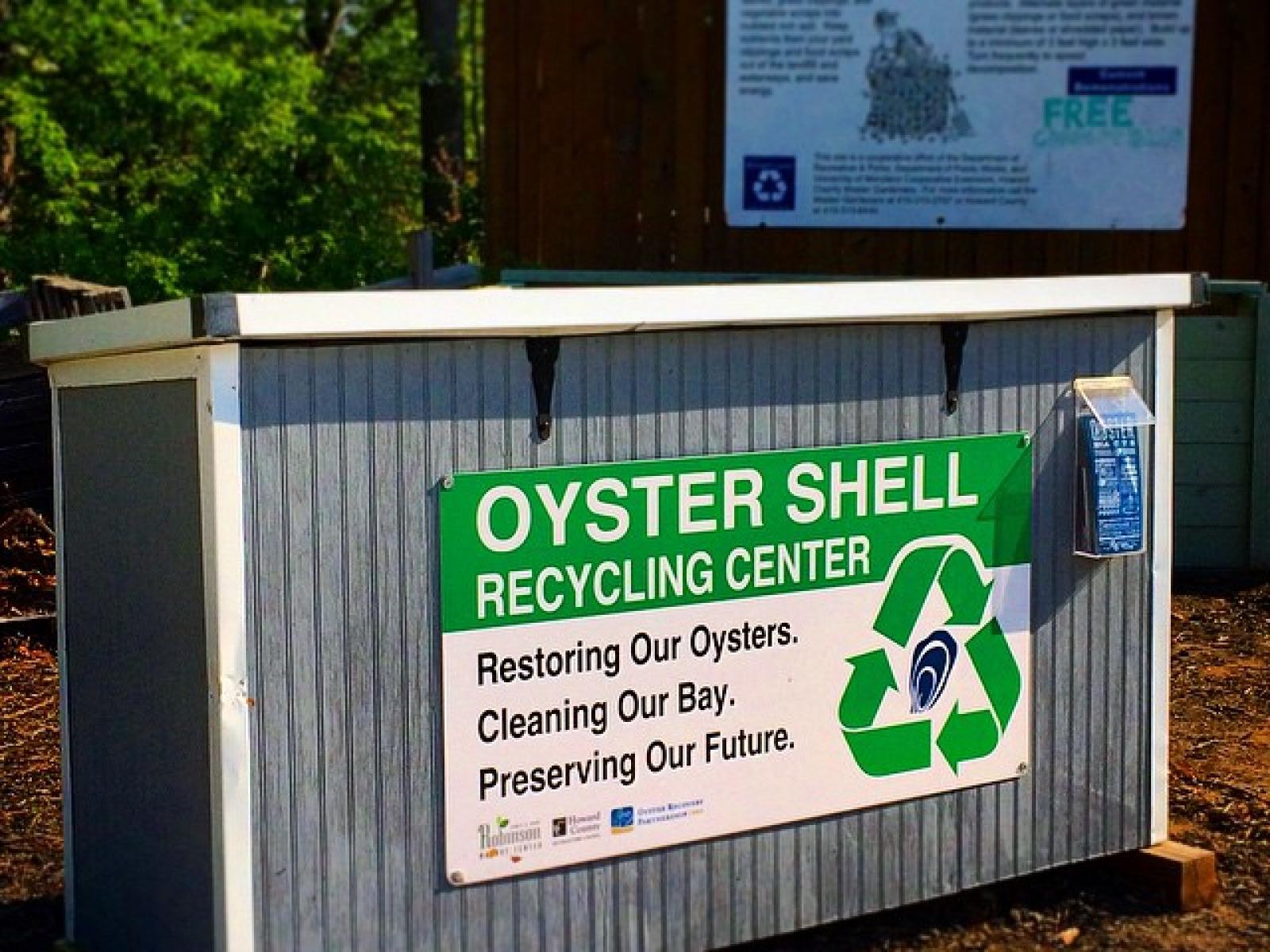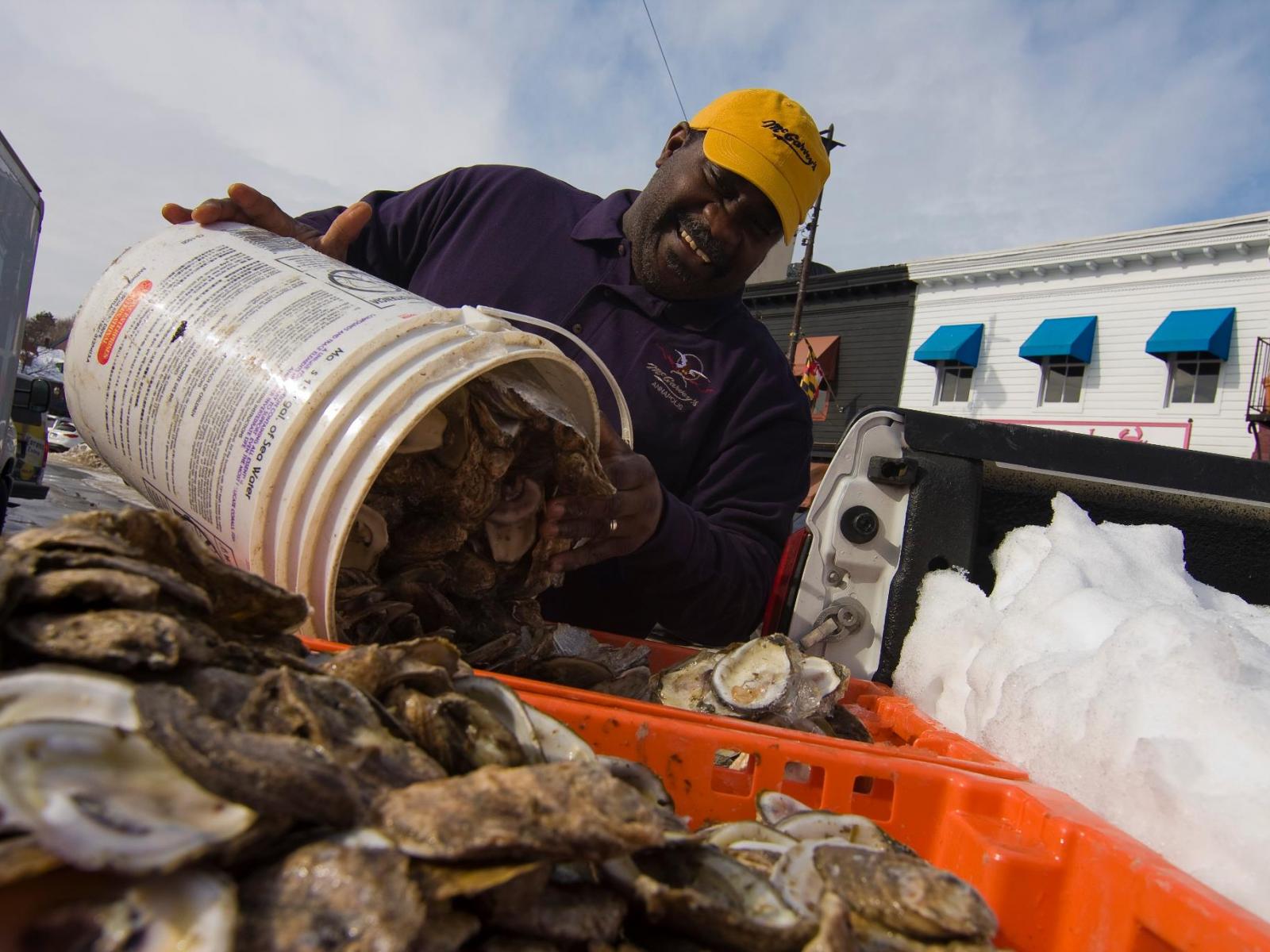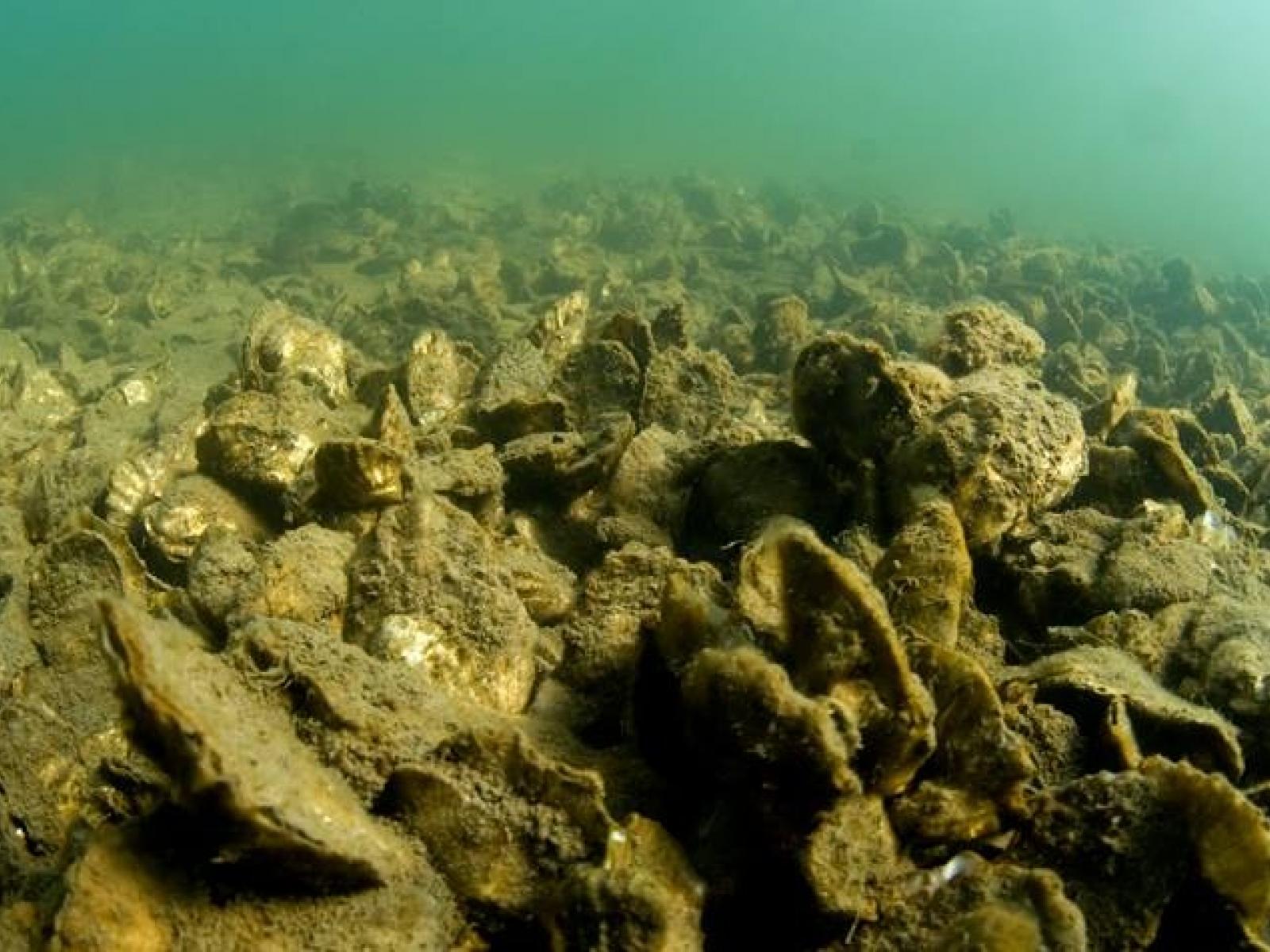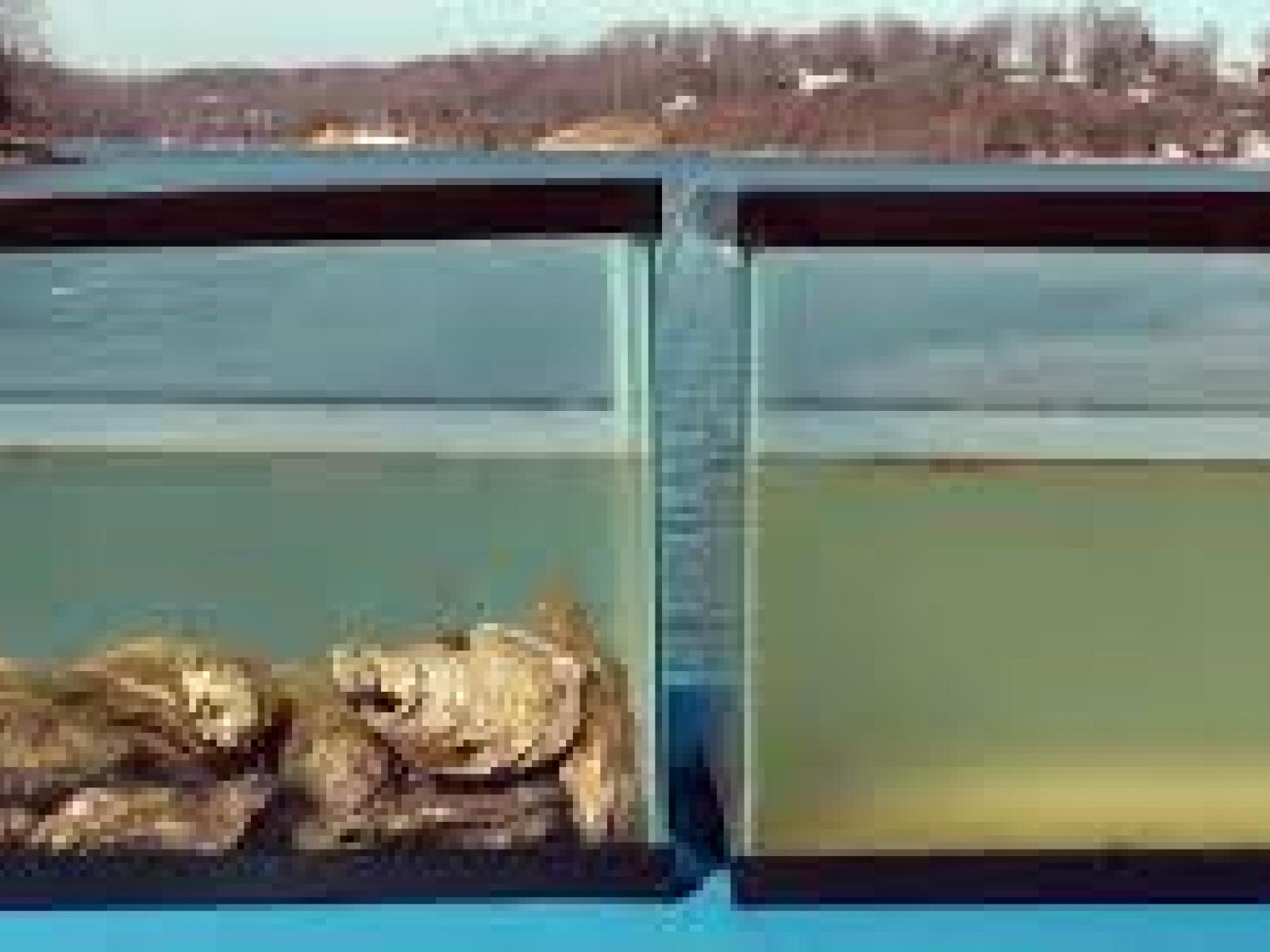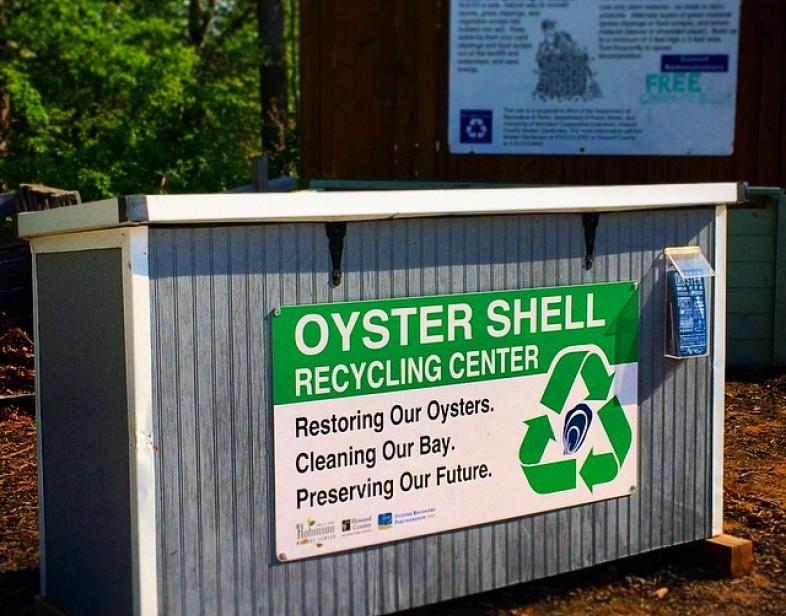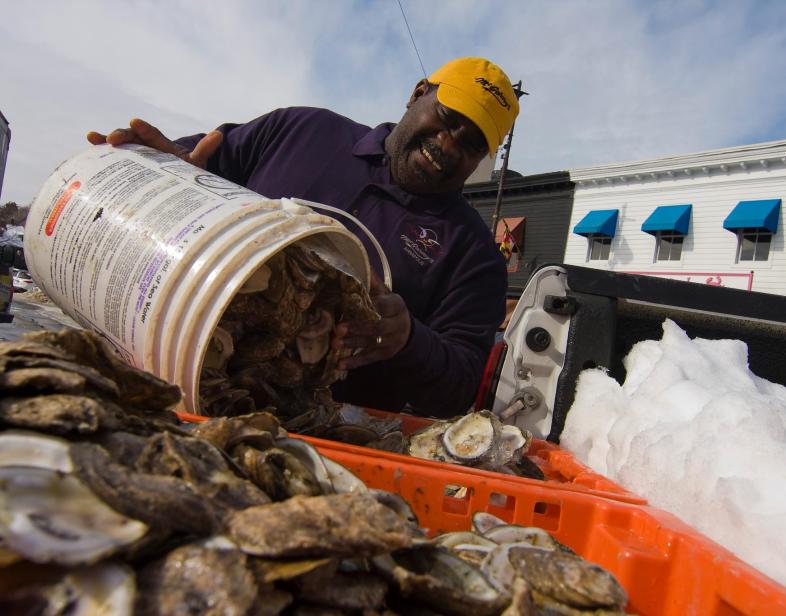An Overview Of Our Solution
The Oyster Recovery Partnership (ORP) recycles oyster shells from hundreds of restaurants and public drop off sites. The recycled shell is cleaned and then used in large-scale oyster restoration work in the Chesapeake Bay. Doing so requires significant and continuous public education about the ecological and economic value of oyster shells as a limited natural resource.
Our crew recycles shell free-of-charge from restaurants, public drop sites, and events throughout the Mid-Atlantic. ORP staff engage restaurants and citizens through one-on-one communication and creative marketing campaigns. We promote shell recycling within the community using restaurant events, educational booths at festivals, and innovative marketing efforts. We rely heavily on low- and no-cost promotions using in-house PR campaigns, videos, blogs, and social media.
- Population Impacted: 18 million
- Continent: North America
First name
Last name
Organization type
Context Analysis
ORP’s Shell Recycling Alliance is promoted to businesses and individuals. It is the nation’s first and largest shell recycling network, collecting 35,000+ bushels of shell each year from more than 300 restaurants in Maryland, Virginia, the District of Columbia, and Pennsylvania and 70 public drop sites. Since 2010, ORP has reclaimed 227,000 bushels, which equates to 8,000 tons of shell kept out of landfills, $350,000 saved by local businesses in waste fees, and enough substrate to support 1 billion new oysters in local waters.
Convincing the community to adopt behaviors that support shell recycling has been difficult. The biggest challenge is getting people to understand why we recycle oyster shells. Shell is heavy, cumbersome, smelly and space consuming. Throwing it in the trash is much easier than saving it. Fortunately, restaurant staff and citizens are eager to recycle once they understand their behavior contributes directly to Chesapeake Bay restoration.
Describe the technical solution you wanted the target audience to adopt
The technical solution to the recycling behavior change challenge is twofold. First, we provide restaurants with no-cost shell recycling, including containers, staff training, and regular shell pickup. We are in constant contact with our restaurant partners to ensure their needs are met, help staff understand the value of used shells, and promote the restaurants as active supporters of Bay restoration. Similarly, we ensure public drop sites are easy to find and use.
Second, we use public and media relations to link oyster shell recycling directly to the Chesapeake Bay. Restaurant patrons, waitstaff, kitchen help, and citizens are constantly reminded that their behavior – even their decisions about where to dine – contributes to oyster restoration and the health of the Bay. Point-of-sale materials, testimonials, traditional and social media stories, annual restaurant recycling awards, and other collateral support the link between recycling behavior and a clean Chesapeake Bay.
Describe your behavioral intervention.
To ensure busy restaurant staff would see it as worth pursuing, we sought to make shell recycling mutually beneficial. We are fortunate to have the "farm-to-table" and sustainability movements on our side and use eco-credentials to promote restaurant participation. We told our story, showed them pictures, explained how critical shell is to our Bay's waters and the seafood they rely on. Initially, restaurant recruitment was done door-to-door, face-to-face. As it grew – and as the public began to link shell recycling with Bay restoration -- more and more restaurants sought its benefits. Simply put, restaurants recognize that environmentally-friendly, eco-conscious behaviors are good for business.
We have changed restaurants’ way of thinking and daily practices. We use in-person meetings, media relations, marketing materials, events, videos, and public awards to discourage throwing shells away or using them for other purposes (driveways or landscaping).
In 2016, we worked with the State of Maryland to create a $5-per-bushel shell recycling tax credit available to restaurants and citizens. ORP is designated as an agent of the State to collect eligible shell and keep precise records for tax purposes. Further, we’ve made it fun to be in the program, spotlighting participants, giving them opportunities to join creative marketing and media campaigns such as annual awards, blogs and press releases. Shell recycling in Maryland is now cool.
Behavioral Levers Utilized
As needed, please explain how you utilized the lever(s) in more detail.
Four of the Center’s six Levers of Behavior Change play prominent roles in shell recycling. We appeal to peoples’ emotions by linking their behaviors with a clean Chesapeake Bay. We demonstrate how the collective actions of hundreds of restaurants and thousands of citizens make a measurable difference in keeping a natural resource out of landfills and using it for the public good. We shower the recycling community with information about how, where, and why oyster shells are reused. And we highlight the significant value of recycling shells – the avoided costs of keeping them out of the waste stream and the financial rewards of diverting them into Bay restoration.
Using these Levers of Change is a group effort and we are fortunate to have great partners in the food and beverage industry that help reach groups of every age and demographic. Our restaurants help tell our story and we use those relationships in mutually beneficial ways that demonstrate eco-friendly behavior.
Describe your implementation
Launching the Shell Recycling Alliance was not easy and we learned lessons along the way.
Shell recycling must be credible. While everyone wants clean water and a healthy Chesapeake Bay, people can be cynical about this paradigm shift. Taking the time to explain shell recycling, making it reliable, easy, and cost free, and explaining how diverting used shells out of the waste stream and into Bay restoration succeeded in convincing restaurants to embrace the efforts.
Shell recycling must reflect the circumstances of each restaurant. Every business has different needs and must be assured that establishing a recycling practice would be easy and beneficial to implement. Hearing them out and creating a plan that would work for them showed we were the experts and eased their concerns.
Shell recycling services must be free of charge. While environmentally conscious practices are helpful, restaurants simply do not want to cut a check for this service. Rather than shift kitchen paradigms, many prefer to give back in more noticeable – and simpler -- ways, such as hosting public fundraising events to showcase our partnership and get more customers in the door. Avoiding waste disposal fees and the state’s $5-per-bushel tax credit help keep the SRA pickups free of charge.
Fostering relationships and communication is key. Restaurant managers and waitstaff are busy to say the least. On a busy Saturday night, water quality is most likely the furthest thing from their minds. But a strong relationship and open lines of communication with management means restaurants are more likely to value the partnership and embrace their role in shell recycling.
We have learned that if we show a commitment to our mission, our restaurant partners and public supporters tend to care too. Checking in, answering questions, showing encouragement, and giving thanks are all valuable relationship builders.
Describe the leadership for your solution. Who is leading the implementation?
ORP's Shell Recycling Alliance solution is led by ORP Executive Director, Ward Slacum; shell recycling manager, Tommy Price, and his on-the-road crew of recyclers; and ORP’s Events and Communications Manager, me, Karis King. Our roles complement one another.
Mr. Slacum oversees the program and helps with large-scale decisions, strategies and budget priorities. Tommy manages the day-to-day logistics: daily pick up schedules, routes, recordkeeping, and fleet management. Mr. Price has terrific people skills and is a detailed-oriented and admired crew leader – precisely the skill set that makes him the perfect man for the job. Tommy oversees the budget and routes, always working to operate more efficiently and effectively.
I excel at and enjoy relationship building with SRA members and bring a public relations and marketing skill set to the Alliance. I am always quick to thank them, celebrate their accomplishments, and create ways to highlight their recycling work.
Share some of the key partners or stakeholders engaged in your solution development and implementation.
In addition to hundreds of restaurants and thousands of citizens, shell recycling partners and audiences include:
Boy Scouts and other community groups who provide volunteer hours and help with shell recycling and shell pile cleanup.
Outdoor recreation groups (anglers, boaters) whose interests align with a clean Chesapeake Bay.
Oyster aquaculturists and commercial watermen whose livelihoods depend on a clean, healthy Chesapeake Bay. ORP’s large-scale oyster restoration work has a profound and measurable impact on clean water.
Corporate partners who seek corporate social responsibility initiatives and look to offset their environmental footprints through hands-on work and donations.
Government partners include the Maryland Department of Natural Resources, the US Army Corps of Engineers, the University of Maryland, and the National Oceanic and Atmospheric Administration. These allies rely on ORP’s expertise on shell recycling and transport. The shell is used for government funded oyster restoration initiatives established under the 2014 Chesapeake Bay Watershed Agreement.
Local and regional businesses who want to give to ORP to support Chesapeake Bay cleanup efforts. This typically focuses on providing a "portion of proceeds" to ORP to help increase their sales and showcase their commitment to their local environment. These partners include local wine, restaurants, beer, seafood, coffee and apparel companies.
Who adopted the desired behavior(s) and to what degree? Include an explanation of how you measured a change in behavior.
More than 300 restaurants, thousands of waitstaff, and countless at-home oyster eaters adopted new behaviors to collectively support our Bay through shell recycling. The concept of shell recycling and behaviors change associated with this activity were foreign to many -- if not most -- of these individuals before the SRA was created.
For the most part, change was measured by total members and the amount of shell collected. We started the program over a decade ago with just a handful of restaurants and shuckers. In our first full year, 2011, we collected 450 bushels of shell. In 2019, before COVID impacted restaurants, we collected 37,077 bushels of oyster shells from 317 restaurants. The Shell Recycling Alliance has seen year-over-year growth every year since it began. The exception, of course, is 2020, due to the severe impact of COVID on restaurants. This illustrates widespread adoption of shell recycling by the public and businesses.
How did you impact water pollution? Please be specific and include measurement methodology where relevant.
To date, ORP has planted more than 8.5 billion oysters in Chesapeake Bay tributaries. A single adult oyster can filter up to 50 gallons of water per day. The exponential impact of billions of oysters filtering the Bay’s waters is a central part of the multi-state Chesapeake Bay strategy.
Restored oysters in Harris Creek on Maryland's Eastern Shore, the largest man-made reef in the world, now filter the entire volume of the creek in less than 10 days. Oysters remove harmful nitrogen, phosphorus and sediment from the waters. Shoreline erosion is also reduced because of better wave energy attenuation. Fish and crabs have returned to these areas because of the protective habitat. Other restoration sites are seeing similar improvements in water quality.
The US Environmental Protection Agency has established the precise nutrient removal capabilities of restored reefs and will soon name oyster restoration a Best Management Practice for the purpose of meeting clean water goals.
How has your solution impacted equity challenges (including race, gender, ethnicity, social class/income, or others)?
The love for oysters knows no bounds and neither does shell recycling. We have restaurant owners, waitstaff, community supporters from different walks of life, communities, religions, ethnicities, socio-economic levels (the list goes on), who simply share a fondness for eating oysters and helping our environment. Having a diverse group of partners and audiences is beneficial because they each offer different skills, talents and perspectives. However, this does pose a challenge because of language barriers. ORP recognized this challenge early and incorporates multi-lingual communications materials for its restaurant partners.
Further, the large-scale restoration made possible by shell recycling improves water quality and reef habitat and increases commercial harvests, adding income to struggling fishing communities. These communities are disproportionately affected by the of COVID-19 due to diminished markets for seafood to restaurants.
What were some social and/or community co-benefits?
Social and community benefits of SRA include a flood of interest from the community to know more. Why is this big truck collecting shells? What are they doing with them? And what's the big deal about oysters anyway? Shell recycling is high profile work that touches many individuals and advances ORP’s mission by broadening our audience beyond restaurants and people eating oysters at home. Shell recycling forces people to think about oysters and how their own behavior effects water quality.
What were some environmental co-benefits?
Environmental co-benefits include less shell waste taking up space in landfills and less fuel used to haul shell away by waste companies. Because oysters are a keystone species in the Chesapeake Bay, we see more fish, crabs, marine species, and other filter feeders in our rivers and streams as they use oyster reefs as habitat. And, of course, the general public is learning about the importance of Bay health and how their behaviors have a real-world impact on water quality.
What were some sustainable development co-benefits?
Each recycled shell can be used to plant up to 10 new juvenile oysters in the water. Although we primarily think of shell being used for restoration purposes, it can also be used to create a fully-sustainable product for restaurants and seafood markets.
How? The shell can be sold to oyster farmers who use it to grow oysters and create a fully-sustainable seafood product. This product filters water every day it is in the water until it is harvested. That oyster shell also is recycled and reused.
Sustainability: Describe the economic sustainability of your solution.
SRA relies heavily on state funding and we currently are working to diversify its revenue streams. Rather than being too reliant on government funds, we raise money to support the program through fundraisers, corporate sponsorships, business partnerships, solicitations, and educational presentations.
The State of Maryland's $5-per-bushel recycling tax credit is a strong incentives for restaurants and citizens to recycle their shell, though its value inures to the recyclers, not to ORP. The credit expires in 2021.
We have significant expertise in the oyster fishery and marketing and are working with restaurants to incorporate and expand oysters on the menu. We intend to develop this as a fee-for-service model.
Return on investment: How much did it cost to implement these activities? How do your results above compare to this investment?
It is difficult to calculate an exact monetary value on the ecological importance of recycled oyster shell but ORP's Shell Recycling Alliance does maintain an operational budget. The recycling operation costs approximately $175,000 per year, including labor, vehicle costs (purchasing, maintenance, and repair), fuel, tolls, permits, equipment, insurance, etc. We aim to keep the cost of recycled shell below $5-per-bushel. Diminished restaurant consumption due to COVID will push the per-bushel costs higher in the near term, of course. It is important to note that the value of the public educational, however, is immeasurable.
How could we successfully replicate this solution elsewhere?
Shell recycling, in practice, has existed in various forms for as long as oysters have been harvested. Only recently have these shells been used for ecological restoration practices rather than for aquaculture, aggregate, or even agricultural uses. ORP’s Shell Recycling Alliance was the first to be established for restoration and is the largest in the United States. Today, nearly 50 similar shell recycling programs exist in the US, with new programs starting around the world.
ORP has helped many shell recycling groups navigate this new field. Our program is fortunate to be centered along the largest estuary in the United States and supports the largest oyster restoration effort in history (the EPA's 2014 Chesapeake Bay Watershed Agreement) but shell is currently needed for nearly every US coastal estuary. Anywhere oyster are sold represents a potential new region for shell recycling. The program is scalable to fit the volume and needs of any tributary.
